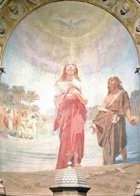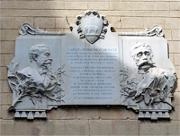
The inscription illustrated above (at number 15 Via Bruschi - see Walk VII) commemorates the residence here of the Domenico Bruschi and his father Carlo, who was a prominent statesman during the liberation of Perugia from papal control in 1859-60.
Domenico Bruschi participated in the events of the 20th June 1859, when papal troops stormed Perugia. He then moved to Florence and to London, where he became part of the Pre-Raphaelite movement. He returned to Italy in 1869, and became one of the important artists of the Risorgimento. He was appointed as a professor at the Accademia di San Luca in Rome in 1870, and was also a prominent member of the Accademia di Belle Arti of Perugia.
Perugia
Work in San Pietro (1857)
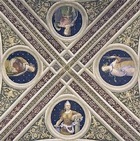
Frescoes (1862)
These frescoes by Domenico Bruschi on the vault of a room in the mezzanine of Palazzo Gallenga Stuart celebrate the unification of Italy.
Frescoes (1869)
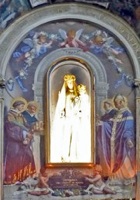
-
✴SS Stephen and Dominic (who holds a model of the church) to the left; and
-
✴the Blessed Tomasello da Perugia (on of the founders of San Domenico) and Pope Benedict XI to the right.
Frescoes (ca. 1873)
These frescoes by Domenico Bruschi in the Palazzo della Provincia comprise:
-
✴those in the vaults of the Sala del Consiglio, which personify
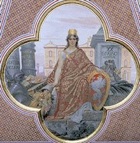
-
•the cities of the Province of Umbria: Perugia (illustrated here); Foligno; Orvieto; Rieti; Terni;and Spoleto;
-
•the Province of Umbria; and
-
•the newly-united Italy; and
-
✴those in the Sala dei Ricevimenti, which depict famous Italians (mostly Perugians). They are split into six categories:
-
•painters (including Perugino and Raphael);
-
•architects (including Galeazzo Alessi);
-
•soldiers (including: Braccio Fortebracci appearing humbly before Pope Martin V in Florence; and two scenes involving Biordo Michelotti: his receipt of a knighthood; and his murder);
-
•goldsmiths and sculptors;
-
•rhetoricians (including Bartolo Alfani di Sassoferrato being appointed as advisor to the Emperor Charles IV); and
-
•men of letters (including Baldo Baldeschi with Galeazzo Visconti).
Baptism of Christ (1876)
Decoration of Palazzo Cesaroni (ca. 1897)
Domenico Bruschi executed the female figures on the mirrors and the fictive tapestries on the walls of the room in Palazzo Cesaroni that is known as Sala Brugnoli. (The room is named for Annibale Brugnoli, who executed the fresco on its ceiling).
Frescoes of SS Annunziata (1878-1901)
The frescoes of the Chiesa della SS Annunziata are by Domenico Bruschi. Those in the apse depict:
-
✴the apocalyptic vision of St John on Patmos, in the lunette; and
-
✴the Visitation of the Virgin to St Elizabeth, the soon-to-be mother of of St John the Baptist;
-
✴the Annunciation; and
-
✴the Annunciation to Zacharius of the birth of St John the Baptist
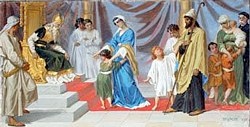
Those in the nave depict scenes from the Old Testament. They include this one, which depicts Hannah presenting her God-given son, Samuel at the Temple. This is Bruschi’s last known work and contains his self-portrait (at the extreme right).
Works in the Museo dell’ Accademia di Belle Arti
Works by Domenico Bruschi in the Museo dell’ Accademia di Belle Arti include:
-
✴a panel (1899) of a woman bathing in a waterfall, which is signed and dated by inscription;
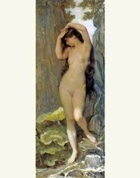
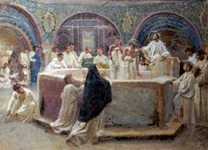
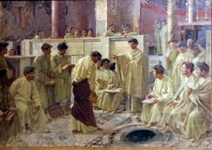
-
✴the designs in oils for two panels (1875-8) that Bruschi painted for the church of Sant’ Agostino, Valletta:
-
•the baptism of St Augustine by St Ambrose; and
-
•St Augustine’s disputation with the Donatists; and


-
✴two late works:
-
•a girl in red (ca. 1905); and
-
•girl in blue (ca. 1905).
[Cappella di Sant’ Onofrio, Duomo]
Amelia
Siege of Amelia (1860)
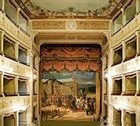
Annunciation (1890)
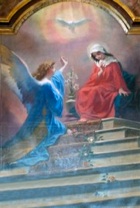
Assisi
Death of St Francis (1886-7)
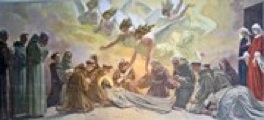
This fresco by Domenico Bruschi is on the exterior wall of the Cappella del Transito in Santa Maria degli Angeli. [Another fresco by Bruschi of the recognition of the stigmata?]
Bevagna
Fire Curtain (ca. 1886)
Domenico Bruschi painted the original fire curtain of the Teatro Francesco Torti in Palazzo dei Consoli. It was replaced during the restoration of the theatre in 1994.
Spoleto
Work in Teatro Caio Melisso (ca. 1880)
Domenico Bruschi decorated the interior of the rebuilt the Teatro Caio Melisso. This work included:
-
✴the apotheosis of Caius Melissus, on the fire curtain; and
-
✴the fresco of Apollo and the muses, on the ceiling.
Trevi
Fire Curtain (1877)
Domenico Bruschi painted the fire curtain of the Teatro Clitunno (see the Walk around Trevi) with a scene of the Emperor Caligula arriving by boat at the Fonti del Clitunno.


